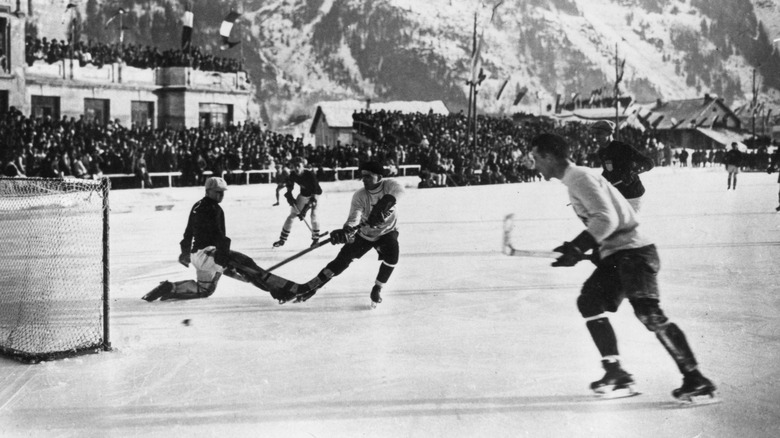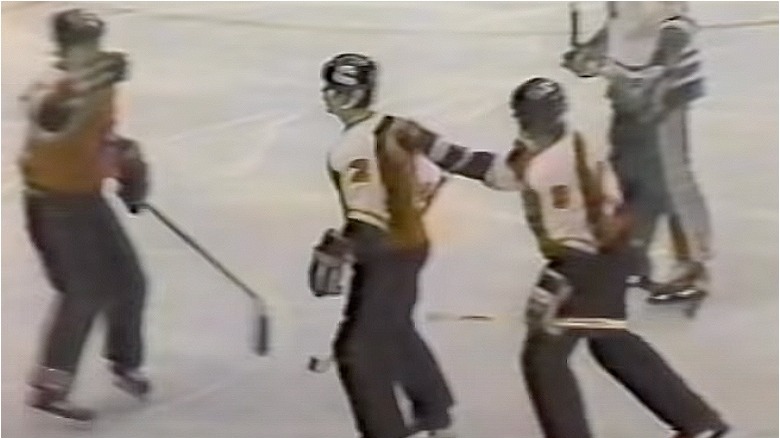Why Do Hockey Players Wear Shorts?
The vast majority of ice hockey players' equipment makes absolute sense. They wear an array of pads all over their body to protect them from crushing body checks and vulcanized rubber hurtling across the surface of the ice. Players wear padded gloves that still allow for some degree of dexterity so players are protected but can still handle the puck. In 1979, the NHL introduced a new rule that all new players entering the league had to wear helmets — which have fairly obvious protection benefits — though players already in the league could continue playing without them (via The New York Times).
Another important piece of equipment is a player's pants. Once again, they're heavily padded, primarily around the waist, hip, and thighs. However, and perhaps confusingly, hockey pants are shorts that typically sit at or just above the wearer's knee. Why wouldn't players wear long pants, considering the sport was born outside, on frozen lakes?
Hockey uniforms' early days
The reason hockey players started wearing shorts to play is thanks to another sport that Canada had a major hand in shaping: football. According to Sportsnet, Canadians developed their version of football at the same time as American university students. In the 1870s, players from Harvard University abandoned their rules — known as the "Boston Game," which was a mix of rugby and soccer — and adopted the version of the game played at Montreal's McGill University, which was more rugby-centric, per History.
The first public indoor hockey game took place in 1875, and at the time most of the players taking the ice to play hockey also played football in warmer months. According to the Hockey Writers, they threw on the same shorts that they wore to play football in the summer while adding a turtleneck for warmth. According to ESPN, players also wore long socks that served the dual purpose of keeping their legs warm and keeping shin pads in place. This has held true throughout hockey history, with the combination of short hockey pants and long, knit socks being messed with only briefly in the early 1980s.
The hockey world is introduced to Cooperalls
In the early 1980s, someone decided that there had to be a better piece of equipment for hockey players to wear. That someone was Cooper, an equipment manufacturer who introduced Cooperalls, which were adopted by the Philadelphia Flyers ahead of the 1981-82 season. Cooperalls are comprised of an elastic girdle with foam pads sewn into them from the ribcage down to the thighs. This isn't drastically different from traditional hockey pants, but Cooperalls then covered the entire thing with nylon, removing the need for traditional hockey socks (via NHL).
Cooperalls received a mixed reaction from fans and players, with Flyers Hall of Fame defenseman Mark Howe remarking, "Most people hated those things." Still, that didn't stop the Flyers and one other club — the Hartford Whalers — from wearing them. The first game in NHL history where both teams wore the long pants happened on December 11, 1982. However, while the pants worn that day are often referred to as Cooperalls, both teams were actually wearing pants made by Cooper's rival manufacturer CCM, called CCM Pro Guards, per Sportsnet.
Cooperalls were a failure
So, why then didn't Cooperalls — or other similar long pants — catch on? For starters, as Mark Howe pointed out, most players didn't like them. Some found that the fit restricted their movement. The garments were also warmer than the traditional pants, which some players disliked and others enjoyed, including Flyers forward Paul Holmgren. "It was weird the first time you put them on but I liked them," Holmgren told NHL. "They were warmer, which I didn't mind. They were very comfortable. I didn't have any problems with them."
Some teams at the junior level also wore Cooperalls, namely the Kitchener Rangers and Penticton Vees, but only the Flyers and Whalers wore them in the NHL (via Sportsnet). This was primarily because of an NHL ban on them ahead of the 1983-84 season. This was done out of safety concerns that the pants' nylon material didn't create enough friction to stop a player who was sliding across the ice, especially if they were headed straight for the boards.



